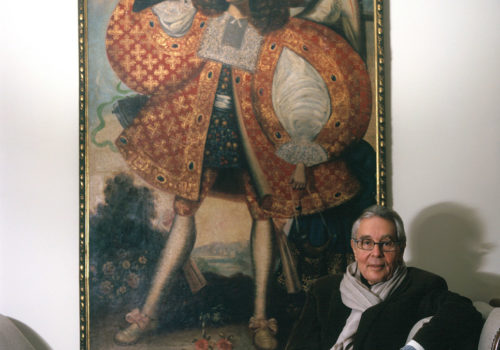Pierre Apraxine and Matthieu Humery are the two curators of the exhibition Irving Penn: Resonance. Apraxine is the legendary curator of the Gilman collection, one of the finest photography collections in the world, which was sold a little over ten years ago to the Metropolitan Museum of New York.
When did you start working on the exhibition?
Matthieu Humery told me last September about François Pinault’s desire to exhibit his collection of Irving Penn photographs in Spring 2014. I went to see the work in the Palazzo Grassi in November. From that moment, I no longer spoke of “I” but only “we,” such was the absolute harmony between me and Matthieu, both in the selection of the work and their presentation.
We worked for two months on the carpet in my apartment, where we designed the exhibition with the photos we had selected. Some of the choices were obvious from the beginning. Lisa Fonssagrives, Penn’s wife, would appear at the beginning and the end. The darkroom, where he worked tirelessly over his prints. The photograph of Picasso, for example, where the final print has little in common with the original photo. Then the piece with 21 animals skulls shot in Prague at the Museum of National History, 21 skulls where the beauty of the prints reaches the sublime. Finally, what we call the “National Geographic” room as a tribute to the portrait of Mr. and Mrs. Gilbert Grosvenor(its editor from 1899 to 1954), where we’ve brought together all of the different types of people photographed by Penn: hippies, Papuans, Bedouins, Hells Angels, WASPs…
Where do the Penn’s prints come from in the collection?
It comes from three sources. First, the Nomura collection, a Japanese collector who was fascinated by Penn and bought many of his works. Intrigued by Nomura’s choices, Penn began a correspondence with her and advised her in her acquisitions. When Nomura died, the collection was prohibited from being separated, so François Pinault purchased it in whole.
Then comes the collection of the director of Irving Penn’s studio, where we find a few never-before-seen marvels, which Penn gave her every year as a sign of his gratitude. Finally, there are the “Small Trades” purchased by François Pinault himself, which he cherishes and which must remind him of his own background.
I’d like to go back to the way we usually approach Irving Penn: the darkness, the shadows, the obsession with death and debris. All of that is true, but it has to be set straight. Penn is about transformation, mutation, a perpetual becoming. That is why we have chosen to highlight this sentence: Life is transience and transformation. It’s a lovely masquerade.
Pierre Apraxine
Born in Estonia and educated in Belgium, Pierre Apraxine resides in New York. As curator for the Gilman Paper Company he assembled a world renowned collection of early photography, now at the Metropolitan Museum of Art, and a collection of visionary architectural drawings now at the Museum of Modern Art. He is a frequent guest curator for the Metropolitan Museum’s Department of Photographs and serves on its Visiting Committee. He also serves on the Architecture and Design Committee of the Museum of Modern Art. Pierre Apraxine has collaborated on exhibitions with the Bibliothèque Nationale de France, the Musée d’Orsay and other French institutions. In 2005, he was made Chevalier de l’Ordre des Arts et des Lettres by the French Republic.
Matthieu Humery
After studying History of Art in Paris and Berlin, Matthieu Humery carried out many projects in the field of contemporary art and photography by working with the Watermill Foundation/Robert Wilson Art Collection (“Summer Archive Project”, two archive exhibitions in 2005 and 2006), for the Magnum agency (Paris Photo 2007), and for the Luma Foundation (exhibitions “How Soon is Now?”, Arles 2011; “To the Moon via the Beach”, Arles 2013), among others. In 2007, he joined Christie’s New York, where he was Head of the Photography department, before moving to the Paris offices in 2010, as Photography Specialist. With Benjamin Millepied he also cofounded the “Los Angeles Dance Project”, an artist collective that aims at presenting dance in all its forms by establishing links between choreographers, artists, musicians, and contemporary authors. The first projects of this new artistic platform were presented in 2012 in Los Angeles at the Music Center Disney Hall and at the Museum of Contemporary Art (MOCA), and, more recently, at the Théâtre du Chatelet in Paris.
















